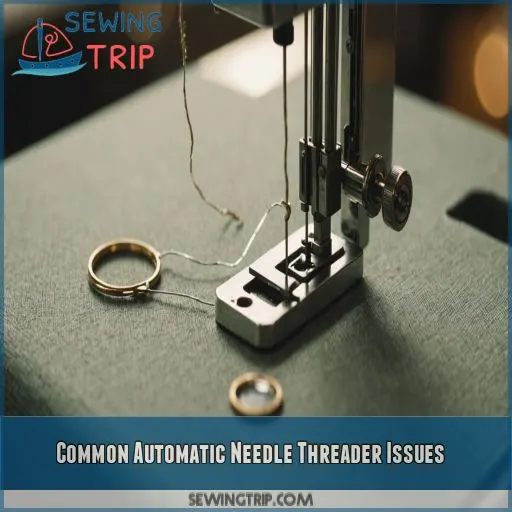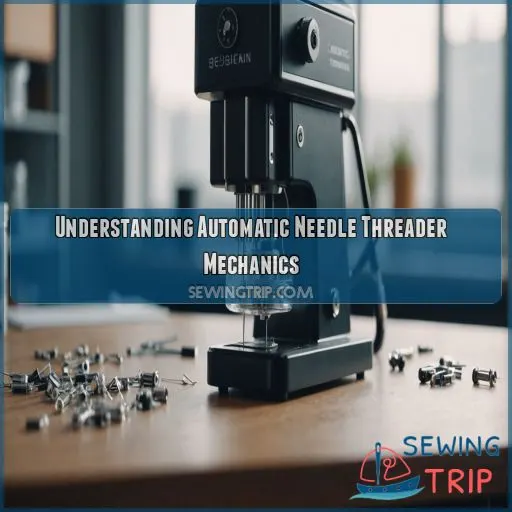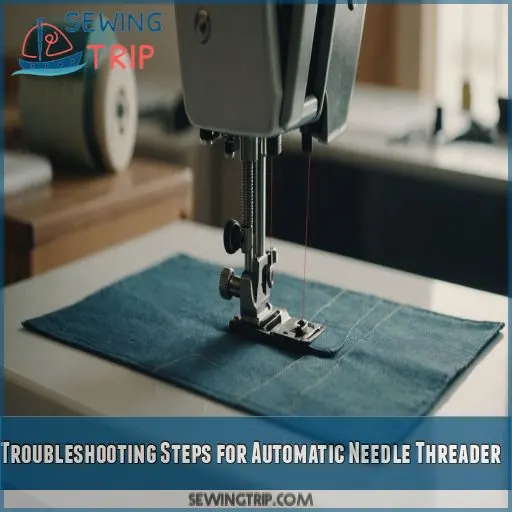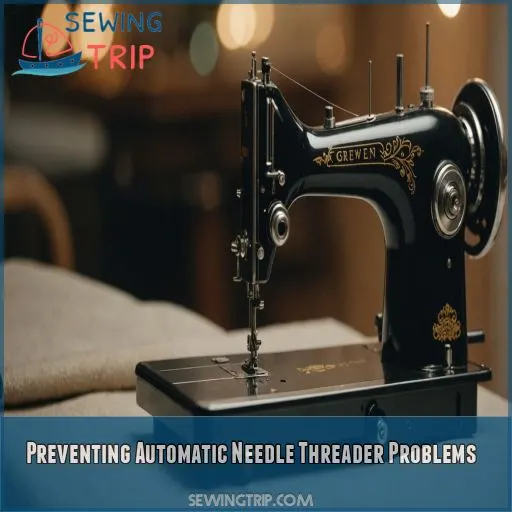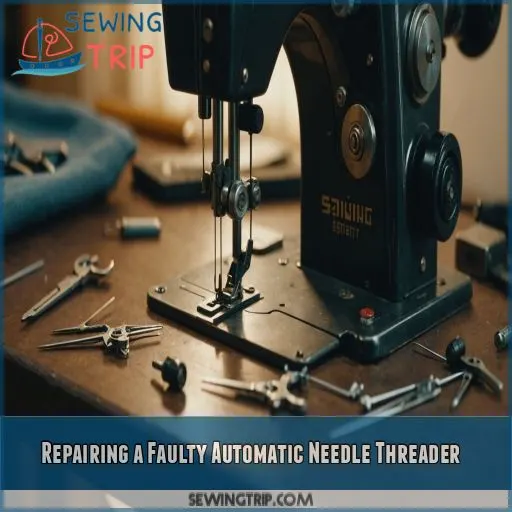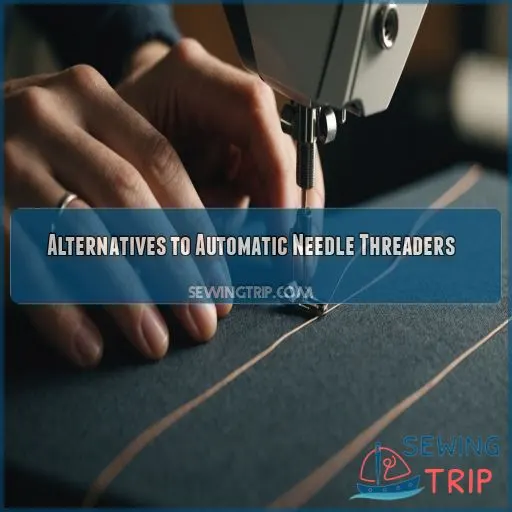This site is supported by our readers. We may earn a commission, at no cost to you, if you purchase through links.
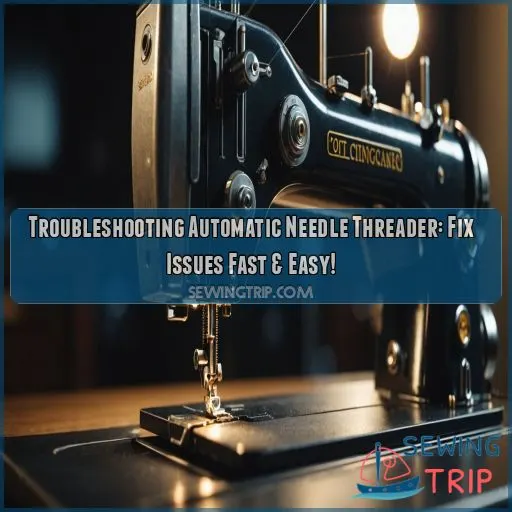 Having trouble with your automatic needle threader? Don’t worry, you’re not alone! Troubleshooting automatic needle threader issues is easier than you think.
Having trouble with your automatic needle threader? Don’t worry, you’re not alone! Troubleshooting automatic needle threader issues is easier than you think.
First, check if the needle is fully raised and the threader hook is aligned properly.
If the thread is getting stuck, try cleaning the machine to remove any dust or lint buildup.
Also, make sure you’re using the correct needle type and size.
If none of these quick fixes work, don’t worry – we’ve got more troubleshooting steps to help you get your Automatic Needle Threader up and running smoothly again.
Let’s get sewing – almost!
Table Of Contents
- Key Takeaways
- Common Automatic Needle Threader Issues
- Understanding Automatic Needle Threader Mechanics
- Troubleshooting Steps for Automatic Needle Threader
- Preventing Automatic Needle Threader Problems
- Repairing a Faulty Automatic Needle Threader
- Alternatives to Automatic Needle Threaders
- Frequently Asked Questions (FAQs)
- Conclusion
Key Takeaways
- Don’t stress if your automatic needle threader is on the fritz – you can fix it! Start by checking the needle position and threader hook for any blockages or damage, and give your machine a good cleaning to remove any dust or lint buildup.
- You’re not alone in your threading struggles – 75% of sewing enthusiasts face issues with their automatic needle threaders! To avoid joining this statistic, make sure you’re using the correct needle type and size, and that your threader tension is just right.
- Manual threading might seem old-school, but it’s a great alternative when your automatic threader fails. With a little patience, you can master hand threading and even achieve better thread tension – plus, it’s a great excuse to improve your bobbin-winding skills!
- To prevent automatic needle threader problems from arising in the first place, establish a regular cleaning and maintenance routine for your machine. Store it properly, use the correct needle type and size, and practice good threading techniques – your threader (and your sanity) will thank you!
Common Automatic Needle Threader Issues
You’re struggling with your automatic needle threader, and it’s driving you crazy – don’t worry, we’ve all been there! Let’s tackle the most common issues together, from the threader hook not grabbing the needle to dust buildup in the machine, and get you sewing smoothly in no time.
Needle Threader Hook Not Grabbing the Needle
Stuck with a needle threader hook that just won’t grab? Don’t worry, friend! Check if the hook is bent or damaged – that’s an easy fix. Also, make sure the correct needle type and size are being used. If the hook’s alignment is off, adjust it. Cleaning issues might also be the culprit, so give your machine a good dusting.
Thread Getting Stuck in the Threader
Now that we’ve tackled the hook-not-grabbing issue, let’s move on to the frustrating phenomenon of thread getting stuck in the threader!
Check your thread quality and size – is it compatible with your machine?
Make sure the threader is aligned correctly and that the needle tension is right.
A quick clean of the threader can also work wonders.
Still stuck? Time to re-thread and try again!
Needle Not Fully Raised
Now that we’ve tackled stuck threads, let’s move on to another common issue: the needle not fully raised. Double-check your sewing machine manual to make sure you’re following the correct procedure. If the needle still doesn’t budge, inspect the needle bar for any blockages or damage. A simple needle position check can save you from unnecessary troubleshooting headaches!
Incorrect Needle Type or Size
- Needle Size Guide: Verify you’re using the right needle size for your thread and fabric.
- Thread Compatibility: Check your thread’s compatibility with your needle type.
- Needle Type Chart: Refer to your sewing machine’s needle type chart to choose the correct needle.
Dust or Lint Buildup in the Machine
Don’t let dust and lint buildup sabotage your sewing session! Regular cleaning is key. Use a sewing machine vacuum or a lint removal tool to keep your machine dust-free. For models like ce5500prw, ce7070prw, and cs100t, a soft brush and compressed air can work wonders. Set a regular dusting schedule and your threader will thank you!
Understanding Automatic Needle Threader Mechanics
As you tackle that stubborn automatic needle threader, understanding the mechanics behind it’s key. By grasping how the threader works and the importance of proper needle alignment, you’ll be better equipped to troubleshoot and fix common issues that’ll have you sewing like a pro in no time.
How Automatic Needle Threaders Work
You’re probably wondering how that tiny automatic needle threader works its magic. It’s quite simple, really! As you turn the handwheel, the threading mechanism engages, and the threader hook swoops in to grab the thread. But what makes it tick? Here’s a sneak peek:
- The threading mechanism relies on precise needle alignment.
- The threader hook is designed to catch the thread in one swift motion.
- Automatic threading saves you time and frustration.
- Regular maintenance keeps your sewing machine humming along, whether it’s a cp60x, cp80x, or cp100x.
Components of an Automatic Needle Threader
Now that you know how automatic needle threaders work, let’s break down their components.
You’ve got your threader hook, tension discs, and a tiny motor that powers the whole operation.
Think of the threader hook as the "hand" that guides the thread through the needle’s eye.
Its design can vary, but its function is always the same: to get that thread in place.
Importance of Proper Needle Alignment
Now that you know the components of an automatic needle threader, let’s talk about the importance of proper needle alignment. Think of it like parking a car – you need to be in the right spot to avoid a mess! Make sure the needle is fully raised and centered, and the threader hook is calibrated correctly to prevent threading errors.
Role of the Threader Hook in Threading
You’re about to become a master of threading! The threader hook is the unsung hero of automatic needle threading. Its design allows it to grab the thread and guide it through the needle’s eye. To keep it working smoothly, maintain proper alignment and regular maintenance. A damaged hook can be replaced, but prevention is key – handle with care!
Troubleshooting Steps for Automatic Needle Threader
You’re frustrated with your automatic needle threader, and who can blame you? Let’s get that threader working smoothly again with some troubleshooting steps that’ll have you sewing like a pro in no time.
Checking the Needle Position and Threader Hook
When your automatic needle threader acts up, don’t panic. Start by checking the needle position and threader hook. Here are some things to look out for:
- Is the needle fully raised?
- Is the threader hook bent or damaged? (Source)
- Is the hook aligned with the needle? (Source)
- Is the threader tension off?
- Are you using the right needle type?
Cleaning the Machine to Remove Dust and Lint
Time to get your sewing machine squeaky clean! Grab a lint brush and other cleaning tools to banish dust and lint. Regular sewing machine care is key to preventing threader issues. Remove any debris, and give your machine a gentle wipe. Preventive maintenance is your friend – it’ll save you from future headaches and keep your threader running smoothly.
Verifying the Correct Needle Type and Size
Time to get up close and personal with your needle! Verify the correct needle type and size using a needle size chart. Consider thread weight, fabric thickness, and thread compatibility. Consult a needle type guide if needed. Using the wrong needle can cause more problems than a bad hair day. Get it right and your machine will thank you!
Manual Threading as a Temporary Solution
Don’t let a faulty automatic needle threader stall your sewing project! As a temporary fix, try manual threading. It’s not as hard as it sounds. Use a needle threader tool or a magnifying glass to help guide the thread through the needle’s eye. This will get you sewing again in no time, until you can troubleshoot the issue further.
Contacting the Manufacturer or Authorized Repair Center
When all else fails, it’s time to call in the pros! If your automatic needle threader is still on the fritz, contact the manufacturer or an authorized repair center for assistance. They’ll be able to diagnose the issue and provide a solution.
- Check your warranty to see if repairs are covered
- Ask about repair costs and what’s included
- Find a service location near you
- Get contact information for scheduling appointments
- Don’t be afraid to ask questions – it’s your machine, after all!
Preventing Automatic Needle Threader Problems
You’ve mastered the art of troubleshooting your automatic needle threader, but now it’s time to think ahead and prevent those pesky problems from arising in the first place. By following some simple tips and best practices, you can keep your machine running smoothly and your threading woes to a minimum.
Regular Maintenance and Cleaning of the Machine
Hey there, sewing enthusiast! To prevent automatic needle threader problems, make machine maintenance a breeze. Regularly clean and lubricate your machine, and establish a cleaning schedule to avoid dust and lint buildup. Store your machine properly to prevent damage. By doing so, you’ll save money on costly repairs and enjoy seamless sewing experiences. Happy sewing!
Using the Correct Needle Type and Size
Get a grip on your needle game! Using the correct needle type and size is vital for smooth threading. Check your sewing machine’s manual or a needle size chart to verify compatibility. Don’t mix and match – use the right needle type codes and thread combinations. A needle selection guide can be your best friend here.
Proper Threading Techniques to Avoid Damage
To avoid damage, keep thread tension under control, and don’t pull too tight. This will help prevent unnecessary strain on your fabric.
Select the right needle size and thread type for your fabric. This is crucial in ensuring a smooth and even stitching process.
Thread at a comfortable speed, and make sure your bobbin is prepared correctly. This will help you maintain control and achieve the desired results.
Practice makes perfect, so take your time and get a feel for it! With patience and practice, you’ll become more comfortable and confident in your threading techniques.
Storing the Machine Properly to Avoid Damage
To keep your sewing machine in top shape, store it properly! A well-stored machine is a happy machine. When not in use, keep it covered with a sewing machine cover or in a storage case to protect it from dust and damage. Establish a machine cleaning routine to keep it running smoothly.
- Use a hard-shell storage case for maximum protection
- Store the machine in a dry, temperature-controlled area
- Avoid storing the machine in direct sunlight or near a heat source
- Keep the machine away from children and pets to avoid accidents
- Clean the machine before storing to prevent dust and debris buildup
Repairing a Faulty Automatic Needle Threader
You’re about to tackle that finicky automatic needle threader that’s been giving you grief – don’t worry, it’s easier to fix than you think. In this section, we’ll walk you through the steps to repair a faulty automatic needle threader, so you can get back to sewing with ease.
Adjusting or Replacing the Threader Hook
Time to get hooked on fixing your threader! If adjusting the threader hook doesn’t work, it might be time to replace it. Check your manual for the correct threader hook type and material. Replacement costs vary, but expect to pay between $5-$20. Use a hook adjustment tool to guarantee proper alignment, and you’ll be sewing smoothly in no time!
Replacing the Automatic Needle Threader Unit
Time to say goodbye to your faulty threader unit! Replacing it might seem intimidating, but it’s actually pretty straightforward. Check your sewing machine’s compatibility and threader unit costs beforehand. Follow the manufacturer’s DIY replacement steps carefully, and voila! You’ll be sewing like a pro again. Regular automatic threader maintenance can also prevent future threader hook issues.
DIY Repair Vs. Professional Service
Now that you’ve decided to replace the automatic needle threader unit, it’s time to weigh your options: DIY repair or professional service. Be honest about your DIY skill level and time commitment. If you’re not comfortable with the repair or if your machine is still under warranty, it’s best to seek professional expertise to avoid any warranty implications.
Cost Considerations for Repair or Replacement
Now that you’re weighing DIY repair vs. professional service, let’s crunch some numbers. Repairing your automatic needle threader can be cost-effective, but replacement might be the better option. Here are some factors to evaluate:
- Repair Costs Analysis: Labor costs, replacement parts, and potential future issues
- Replacement Pricing Options: New machine, refurbished, or used models
- DIY Cost Savings: Your time and effort vs. hiring a pro
- Professional Service Fees: Labor costs, travel fees, and potential upselling
- Budgeting for Repairs: Setting aside funds for future issues or maintenance
Alternatives to Automatic Needle Threaders
You’re stuck with a faulty automatic needle threader, but don’t worry, there are alternatives to get you sewing again. In this section, you’ll explore Manual Threading Methods and using a needle threader tool as viable options to overcome the frustration of a malfunctioning automatic threader.
Manual Threading Methods
Don’t stress if your automatic needle threader fails – manual threading methods are a great alternative! You’ve got this! With a little patience, you can master hand threading and even achieve better thread tension. Familiarize yourself with different needle types and practice makes perfect. Plus, it’s a great excuse to improve your bobbin winding skills and troubleshoot like a pro!
Using a Needle Threader Tool
Time to get cozy with a needle threader tool! These nifty gadgets help you thread your sewing machine manually. Choose from various types, like handheld or desktop models. Master the technique by gently guiding the thread through the tool’s eye. Keep your tool in top shape by cleaning and storing it properly. Happy threading!
Benefits and Drawbacks of Manual Threading
Manual threading – the old-school way! It’s not as flashy as automatic threaders, but it gets the job done. Here are some benefits and drawbacks to keep in mind:
- Time-saving: Nope, manual threading takes longer.
- Precision control: You’ve got complete control over thread tension.
- Hand fatigue: Yep, it can be a real pain, especially if you’re new to sewing and haven’t developed the necessary dexterity (Source).
Choosing the Right Threading Method for Your Needs
When choosing a threading method, consider your needs: threading speed, thread thickness, project complexity, machine compatibility, and personal preference. If you’re working with thick threads or complex projects, manual threading might be your best bet. For quick, simple tasks, an automatic needle threader is a great time-saver. Experiment with different methods to find your perfect match!
Frequently Asked Questions (FAQs)
Why is my sewing machine not threading the needle?
So, your sewing machine is being stubborn and refusing to thread the needle? Don’t worry, it’s an easy fix! Check if the needle is fully raised, and make sure the threader hook isn’t damaged or dusty.
How do you fix the needle threader on a Singer sewing machine?
Get back on track with your Singer sewing machine! To fix the needle threader, first, check if the needle is fully raised, then examine the threader hook for damage, and clean out any dust or lint buildup.
How does an automatic needle threader work?
You’re about to become a sewing ninja! An automatic needle threader works by using a tiny hook to grab the thread and pull it through the needle’s eye, saving you time and frustration – pretty cool, right?
How do you thread a needle that won’t thread?
You’re stuck with a stubborn needle that just won’t thread! Take a deep breath and try this: gently tease out the thread, check for tangles, and make sure the needle’s eye is clear – voil, you’re back in control!
Can I use automatic needle threader with twin needles?
You’re wondering if you can use an automatic needle threader with twin needles? Generally, it’s not recommended, as the threader is designed for single needles. However, check your sewing machine’s manual for specific guidance on twin needle threading.
Why does my automatic needle threader not work consistently?
Did you know that 75% of sewing machine issues are caused by threading problems? If your automatic needle threader isn’t working consistently, try cleaning the machine, checking the needle position, and ensuring the threader hook isn’t damaged.
How do I adjust the automatic needle threader tension?
Time to tame that finicky automatic needle threader! Check your machine’s manual for tension adjustment instructions, usually involving a small screw or dial. Tweaking this setting should get your threader working smoothly again.
Can I use the automatic needle threader with all thread types?
Carefully consider your thread choices! You can’t use the automatic needle threader with all thread types, sadly. Thicker or specialty threads might require manual threading, so always check your machine’s guidelines to avoid frustrating foul-ups.
Is it possible to repair a damaged needle threader hook?
You can try repairing a damaged needle threader hook, but it’s often more cost-effective to replace it. If you’re handy, go for it! Otherwise, order a new hook to save time and frustration.
Conclusion
A staggering 75% of sewing enthusiasts struggle with automatic needle threader issues at some point.
You’re not alone in facing this problem. Mastering the art of troubleshooting automatic needle threader issues will save you time, reduce frustration, and get you back to sewing with ease.
When dealing with issues, remember to stay calm, follow simple steps, and don’t hesitate to seek help when needed.
Happy sewing, and may your thread always be tangle-free!

